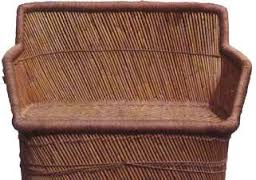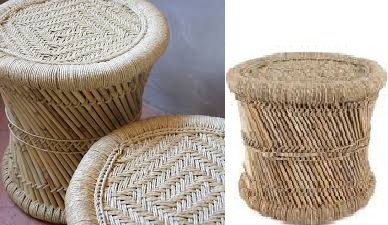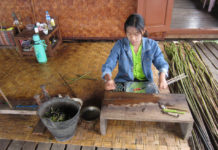The knowledge of plant fibres and its processing into bridges or containers or mats or other items is based on age old learnings, innovative experiments and local requirements. In Haryana sarkanda grass or sweet cane (Saccharum munja) is used to craft light-weight sturdy furniture that is used all over India. While little is known of its history photographic evidence from the British Raj shows that it was commonly used in the colonial period as garden furniture.
 This wild perennial grass grows to a height of four feet in dried river beds and is harvested annually in the winter months. Once dried every part of the plant is used. The long thick stems are used to make furniture, its outer skin to thatch roofs. Its top half (tuli) is coiled into a variety of baskets, while its feathery leaf (munj) is processed into sturdy ropes.
This wild perennial grass grows to a height of four feet in dried river beds and is harvested annually in the winter months. Once dried every part of the plant is used. The long thick stems are used to make furniture, its outer skin to thatch roofs. Its top half (tuli) is coiled into a variety of baskets, while its feathery leaf (munj) is processed into sturdy ropes.
The construction of Sarkanda furniture is based on a system of dual layering. The stems are ingeniously twisted in opposite directions to both construct and to strengthen the hollow base. Munj ropes lock-in the twist, being interwoven through the stems at three different levels, thus binding the stems and stabilising the base. The seat is woven and patterned with munj or in bright coloured nylon cording. The range of furniture and sizes made include the mooda or round stool, armchairs with curved backrests, two and three seater sofas, tables and more.
Locally made tools are used in the crafting and include a range of knives and sickles, needles and a mallet. The baskets are made by women from agricultural families, but the furniture is only made by craftspeople from the Balmiki community who are spread across Gurgaon, Rewari, Mahendragarh and Faridabad districts of Haryana






Sir I am student ….and manufacturer of this type of muurdhaa….I want to do business with you….I provide to you any type of this type off furniture….I need a bussines for save my career and my life…my family condition is very poor…plss help me sir….contact me 9084195198
Hello,
Can u send some details of the items u make?